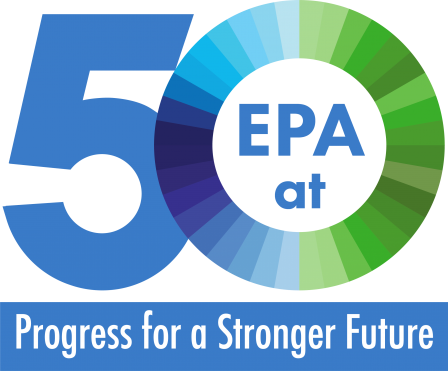EPA Science at 50: Progress for a Stronger Future
Published January 22, 2020
 This year marks the 50th Anniversary of the establishment of the Environmental Protection Agency (EPA). This important milestone gives us an opportunity to look back at the many success stories the Agency has forged advancing its mission to protect public health and safeguard the natural environment.
This year marks the 50th Anniversary of the establishment of the Environmental Protection Agency (EPA). This important milestone gives us an opportunity to look back at the many success stories the Agency has forged advancing its mission to protect public health and safeguard the natural environment.
Science has played an integral part of that narrative.
Every step along the way has been grounded in a solid foundation of science. Our researchers and their partners from across the scientific community have provided the data, knowledge, and tools needed to tackle the most pressing environmental and related health challenges the nation has faced. In doing so, EPA researchers have pioneered the field of environmental science, defining it as an interdisciplinary field of research focused on illuminating the links between our own health and well-being and the natural environment we share.
Over the course of 2020 we’ll be highlighting EPA’s most important scientific milestones. You can also learn about some of the many accomplishments by our researchers and engineers on the History of EPA Research.
Our retrospective will feature how those discoveries have led to the cleaner, safer, and more prosperous environment we enjoy today. It helps us to remember that EPA was created at a time when our cities were commonly subjected to dangerous levels of air pollution and rivers would famously ignite, sending plumes of thick, black clouds of smoke into surrounding communities.
At a time of growing concern for the environment, EPA’s scientific enterprise embraced a solutions-oriented, “can do” spirit and began to provide the data and information the Agency and the nation needed to craft, enact, and enforce a new generation of laws and regulations specifically designed to lower risks from environmental contamination and pollution.
And they delivered.
Early risk assessments became the underpinnings of landmark environmental laws such as the Clean Air Act and the Clean Water Act. EPA research supported the development of the first Air Quality Criteria documents, providing the most comprehensive scientific knowledge to date on the health effects of air pollutants and the basis for establishing national air quality standards for six common air pollutants under the Clean Air Act.
Agency researchers tackled many early public health concerns. They helped to identify the health risks of second-hand tobacco smoke, and the detrimental effects of lead in gasoline. They investigated health concerns of widely-used classes of chemicals such as PCBs, and conducted the first-ever assessments of major ecosystems such as U.S. coastal waters with the creation of the Environmental Monitoring and Mapping Program.
When a mysterious cluster of diseases struck the community of Love Canal in upstate New York, EPA researchers conducted a comprehensive multimedia monitoring study of the area to find out why. This work helped pave the way for the passing of the Comprehensive Environmental Response, Compensation, and Liability Act, otherwise known as the Superfund Act. That legislation marked a new era of environmental stewardship and responsibility. Since then, EPA researchers have continued to pioneer the science and technology of cleaning up contaminated sites for the benefit of local communities.
The examples noted above were just the beginning. Agency scientists and engineers have been called upon to respond to a host of environmental challenges over the last 50 years. Today, EPA is at the forefront of investigating new environmental challenges, including the impacts of wildfire smoke on air quality, contamination from widely-used, persistent chemicals such as Per- and polyfluoroalkyl substances (PFAS), the contributions that natural ecosystems make to human well-being, and the rapid evaluation of chemical toxicity through computational toxicology. Our scientists are developing innovative monitoring and assessment and helping states and communities address their immediate environmental challenges in ways that also make them more resilient and better prepared for any future threats.
Since the establishment of the EPA, the Agency has been committed to providing the science it needs to meet its mission. That 50-year effort continues to this day, embracing innovation and discovery as it sows the seeds for a healthier, cleaner, and more prosperous future.
We invite you to continue reading Science Matters throughout the year as we highlight a half century of EPA scientific achievements.
